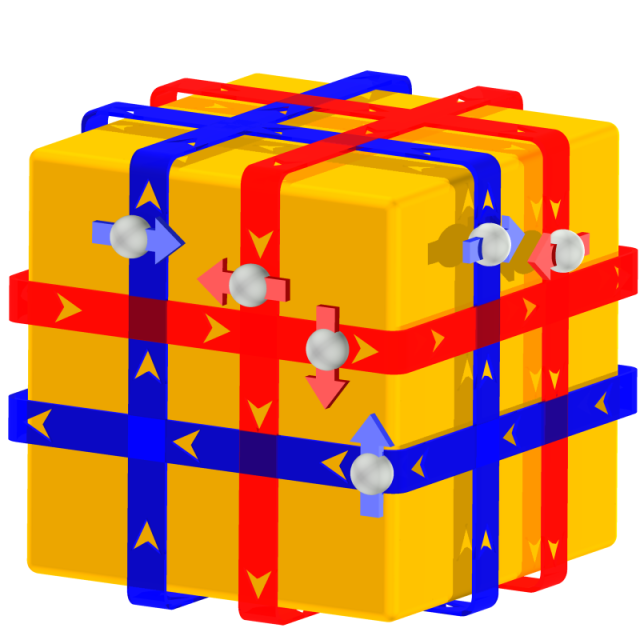
Resonant Elastic X-Ray Scattering of Antiferromagnetic Superstructures in EuPtSi3
W. Simeth, A. Bauer, C. Franz, A. Aqeel, P. J. Bereciartua, J. A. Sears, S. Francoual, C. H. Back, C. Pfleiderer
Physical Review Letters 130 (26), 266701 American Physical Society, (2023).
We report resonant elastic x-ray scattering of long-range magnetic order in EuPtSi3, combining different scattering geometries with full linear polarization analysis to unambiguously identify magnetic scattering contributions. At low temperatures, EuPtSi3 stabilizes type A antiferromagnetism featuring various long -wavelength modulations. For magnetic fields applied in the hard magnetic basal plane, well-defined regimes of cycloidal, conical, and fanlike superstructures may be distinguished that encompass a pocket of commensurate type A order without superstructure. For magnetic field applied along the easy axis, the phase diagram comprises the cycloidal and conical superstructures only. Highlighting the power of polarized resonant elastic x-ray scattering, our results reveal a combination of magnetic phases that suggest a highly unusual competition between antiferromagnetic exchange interactions with Dzyaloshinsky-Moriya spin-orbit coupling of similar strength.

Experimental demonstration of a skyrmion-enhanced strain-mediated physical reservoir computing system
Y. M. Sun, T. Lin, N. Lei, X. Chen, W. Kang, Z. Y. Zhao, D. H. Wei, C. Chen, S. M. Pang, L. L. Hu, L. Yang, E. X. Dong, L. Zhao, L. Liu, Z. Yuan, A. Ullrich, C. H. Back, J. Zhang, D. Pan, J. H. Zhao, M. Feng, A. Fert, W. S. Zhao
Nature Communications 14 (1), 3434 (2023).
Physical reservoirs holding intrinsic nonlinearity, high dimensionality, and memory effects have attracted considerable interest regarding solving complex tasks efficiently. Particularly, spintronic and strain-mediated electronic physical reservoirs are appealing due to their high speed, multi-parameter fusion and low power consumption. Here, we experimentally realize a skyrmion-enhanced strain-mediated physical reservoir in a multiferroic heterostructure of Pt/Co/Gd multilayers on (001)-oriented 0.7PbMg(1/3)Nb(2/3)O(3)-0.3PbTiO(3) (PMN-PT). The enhancement is coming from the fusion of magnetic skyrmions and electro resistivity tuned by strain simultaneously. The functionality of the strain-mediated RC system is successfully achieved via a sequential waveform classification task with the recognition rate of 99.3% for the last waveform, and a Mackey-Glass time series prediction task with normalized root mean square error (NRMSE) of 0.2 for a 20-step prediction. Our work lays the foundations for low-power neuromorphic computing systems with magneto-electro-ferroelastic tunability, representing a further step towards developing future strain-mediated spintronic applications. An energy-efficient physical reservoir is crucial for reservoir computing (RC). Here the authors demonstrate an all-electric skyrmion-enhanced strain-mediated physical RC system and achieve a benchmark chaotic time series prediction.

Hybrid magnetization dynamics in Cu2OSeO3/NiFe heterostructures
C. Luethi, L. Flacke, A. Aqeel, A. Kamra, R. Gross, C. Back, M. Weiler
Applied Physics Letters 122 (1), 12401 (2023).
We investigate the coupled magnetization dynamics in heterostructures of a single crystal of the chiral magnet Cu 2 OSeO 3 (CSO) and a polycrystalline ferromagnet NiFe (Py) thin film using broadband ferromagnetic resonance (FMR) at cryogenic temperatures. We observe the excitation of a hybrid mode (HM) below the helimagnetic transition temperature of CSO. This HM is attributed to the spin dynamics at the CSO/Py interface. We study the HM by measuring its resonance frequencies for in plane rotations of the external magnetic field. We find that the HM exhibits dominantly fourfold anisotropy in contrast to the FMR of CSO and Py.

Chiral surface spin textures in Cu2OSeO3 unveiled by soft X-ray scattering in specular reflection geometry
V. Ukleev, C. Luo, R. Abrudan, A. Aqeel, C. H. Back, F. Radu
Science and Technology of Advanced Materials 23 (1), 682-690 (2022).
Resonant elastic soft X-ray magnetic scattering (XRMS) is a powerful tool to explore long-periodic spin textures in single crystals. However, due to the limited momentum transfer range imposed by long wavelengths of photons in the soft x-ray region, Bragg diffraction is restricted to crystals with the large lattice parameters. Alternatively, small-angle X-ray scattering has been involved in the soft energy X-ray range which, however, brings in difficulties with the sample preparation that involves focused ion beam milling to thin down the crystal to below a few hundred nm thickness. We show how to circumvent these restrictions using XRMS in specular reflection from a sub-nanometer smooth crystal surface. The method allows observing diffraction peaks from the helical and conical spin modulations at the surface of a Cu2OSeO3 single crystal and probing their corresponding chirality as contributions to the dichroic scattered intensity. The results suggest a promising way to carry out XRMS studies on a plethora of noncentrosymmetric systems hitherto unexplored with soft X-rays due to the absence of the commensurate Bragg peaks in the available momentum transfer range. [GRAPHICS] .

Non-reciprocity of vortex-limited critical current in conventional superconducting micro-bridges
D. Suri, A. Kamra, T. N. G. Meier, M. Kronseder, W. Belzig, C. H. Back, C. Strunk
Applied Physics Letters 121 (10), 102601 (2022).
Non-reciprocity in the critical current has been observed in a variety of superconducting systems and has been called the superconducting diode effect. The origin underlying the effect depends on the symmetry breaking mechanisms at play. We investigate superconducting micro-bridges of NbN and also NbN/magnetic insulator (MI) hybrids. We observe a large diode efficiency of approximate to 30% when an out-of-plane magnetic field as small as 25 mT is applied. In both NbN and NbN/MI hybrid, we find that the diode effect vanishes when the magnetic field is parallel to the sample plane. Our observations are consistent with the critical current being determined by the vortex surface barrier. Unequal barriers on the two edges of the superconductor strip result in the diode effect. Furthermore, the rectification is observed up to 10 K, which makes the device potential for diode based applications over a larger temperature range than before.

Growth and Helicity of Noncentrosymmetric Cu2OSeO3 Crystals
A. Aqeel, J. Sahliger, G. W. Li, J. Baas, G. R. Blake, T. T. M. Palstra, C. H. Back
Physica Status Solidi B-Basic Solid State Physics 259 (5), 2100152 (2022).
Cu2OSeO3 single crystals are grown with an optimized chemical vapor transport technique using SeCl4 as a transport agent (TA). The optimized growth method allows to selectively produce large high-quality single crystals. The method is shown to consistently produce Cu2OSeO3 crystals of maximum size 8 x 7 x 4 mm with a transport duration of around three weeks. It is found that this method, with SeCl4 as TA, is more efficient and simple compared with the commonly used growth techniques reported in literature with HCl gas as TA. The Cu2OSeO3 crystals have very high quality and their absolute structures are fully determined by simple single-crystal X-ray diffraction. Enantiomeric crystals with either left- or right-handed chiralities are observed. The magnetization and ferromagnetic resonance data show the same magnetic phase diagram as reported earlier.

Hybridized magnon modes in the quenched skyrmion crystal
R. Takagi, M. Garst, J. Sahliger, C. H. Back, Y. Tokura, S. Seki
Physical Review B 104 (14), 144410 (2021).
Magnetic skyrmions have attracted attention as particlelike swirling spin textures with nontrivial topology, and their self-assembled periodic order i.e., the skyrmion crystal (SkX) is anticipated to host unique magnonic properties. In this paper, we investigate magnetic resonance in the quenched SkX state, which is obtained by the rapid cooling of the high-temperature equilibrium SkX phase in the chiral magnetic insulator Cu2OSeO3. At low temperatures, sextupole and octupole excitation modes of skyrmions are identified, which are usually inactive for oscillating magnetic fields B-nu with GHz-range frequency. but turn out to be detectable through the hybridization with the B-nu-active counterclockwise and breathing modes, respectively. The observed magnetic excitation spectra are well reproduced by theoretical calculations, which demonstrates that the effective magnetic anisotropy enhanced at low temperatures is the key for the observed hybridization between the B.-active and B-nu-inactive modes.

Spin structure relation to phase contrast imaging of isolated magnetic Bloch and Neel skyrmions (vol 212, 112973, 2020)
S. Pollath, T. Lin, N. Lei, W. Zhao, J. Zweck, C. H. Back
Ultramicroscopy 223, 113224 (2021).
Several errors are present in the text and Fig. 3 of the article Ultramicroscopy 212 (2020) 112973. This includes minor confusions concerning the skyrmion helicities and a wrong orientation of a color wheel that represents the electron phase gradient direction. Further, the presented correction factors for finite probe sizes were based on an erratic simulation which is now corrected. This leads to different error values for the measured skyrmion size. These flaws do not affect the main message of the paper which is the relation of the skyrmion structure with the electron phase at all. They only affect the small section of the proof of principle skyrmion size measurement where aberrations were included.

All-electrical detection of skyrmion lattice state and chiral surface twists
A. Aqeel, M. Azhar, N. Vlietstra, A. Pozzi, J. Sahliger, H. Hübl, T. T. M. Palstra, C. H. Back, M. Mostovoy
Physical Review B 103 (10), L100410 (2021).
We study the high-temperature phase diagram of the chiral magnetic insulator Cu2OSeO3 by measuring the spin-Hall magnetoresistance (SMR) in a thin Pt electrode. We find distinct changes in the phase and amplitude of the SMR signal at critical lines separating different magnetic phases of bulk Cu2OSeO3. The skyrmion lattice state appears as a strong dip in the SMR phase. A strong enhancement of the SMR amplitude is observed in the conical spiral state, which we explain by an additional symmetry-allowed contribution to the SMR present in noncollinear magnets. We demonstrate that the SMR can be used as an all-electrical probe of chiral surface twists and skyrmions in magnetic insulators.

Microwave Spectroscopy of the Low-Temperature Skyrmion State in Cu2OSeO3
A. Aqeel, J. Sahliger, T. Taniguchi, S. Mandl, D. Mettus, H. Berger, A. Bauer, M. Garst, C. Pfleiderer, C. H. Back
Physical Review Letters 126 (1), 17202 (2021).
In the cubic chiral magnet Cu2OSeO3 a low-temperature skyrmion state (LTS) and a concomitant tilted conical state are observed for magnetic fields parallel to h100i. Here, we report on the dynamic resonances of these novel magnetic states. After promoting the nucleation of the LTS by means of field cycling, we apply broadband microwave spectroscopy in two experimental geometries that provide either predominantly in-plane or out-of-plane excitation. By comparing the results to linear spin-wave theory, we clearly identify resonant modes associated with the tilted conical state, the gyrational and breathing modes associated with the LTS, as well as the hybridization of the breathing mode with a dark octupole gyration mode mediated by the magnetocrystalline anisotropies. Most intriguingly, our findings suggest that under decreasing fields the hexagonal skyrmion lattice becomes unstable with respect to an oblique deformation, reflected in the formation of elongated skyrmions.

The 2020 Skyrmionics roadmap
C.H. Back, V. Cros, H. Ebert, K. Everschor-Sitte, A. Fert, M. Garst, Tianping Ma, S. Mankovsky, T. L. Monchesky, M. Mostovoy, N. Nagaosa, S.S.P. Parkin, C. Pfleiderer, N. Reyren, A. Rosch, Y. Taguchi, Y. Tokura, K. von Bergmann, J. Zang
Journal of Physics D: Applied Physics 53, 363001 (2020).
The notion of non-trivial topological winding in condensed matter systems represents a major area of present-day theoretical and experimental research. Magnetic materials offer a versatile platform that is particularly amenable for the exploration of topological spin solitons in real space such as skyrmions. First identified in non-centrosymmetric bulk materials, the rapidly growing zoology of materials systems hosting skyrmions and related topological spin solitons includes bulk compounds, surfaces, thin films, heterostructures, nano-wires and nano-dots. This underscores an exceptional potential for major breakthroughs ranging from fundamental questions to applications as driven by an interdisciplinary exchange of ideas between areas in magnetism which traditionally have been pursued rather independently. The skyrmionics Roadmap provides a review of the present state of the art and the wide range of research directions and strategies currently under way. These are, for instance, motivated by the identification of the fundamental structural properties of skyrmions and related textures, processes of nucleation and annihilation in the presence of non-trivial topological winding, an exceptionally efficient coupling to spin currents generating spin transfer torques at tiny current densities, as well as the capability to purpose-design broad-band spin dynamic and logic devices.

Spin structure relation to phase contrast imaging of isolated magnetic Bloch and Neel skyrmions
S. Pollath, T. Lin, N. Lei, W. Zhao, J. Zweck, C. H. Back
Ultramicroscopy 212, 112973 (2020).
Magnetic skyrmions are promising candidates for future storage devices with a large data density. A great variety of materials have been found that host skyrmions up to the room-temperature regime. Lorentz microscopy, usually performed in a transmission electron microscope (TEM), is one of the most important tools for characterizing skyrmion samples in real space. Using numerical calculations, this work relates the phase contrast in a TEM to the actual magnetization profile of an isolated Neel or Bloch skyrmion, the two most common skyrmion types. Within the framework of the used skyrmion model, the results are independent of skyrmion size and wall width and scale with sample thickness for purely magnetic specimens. Simple rules are provided to extract the actual skyrmion configuration of pure Bloch or Neel skyrmions without the need of simulations. Furthermore, first differential phase contrast (DPC) measurements on Neel skyrmions that meet experimental expectations are presented and showcase the described principles. The work is relevant for material sciences where it enables the engineering of skyrmion profiles via convenient characterization.

Ferromagnetic Resonance with Magnetic Phase Selectivity by Means of Resonant Elastic X-Ray Scattering on a Chiral Magnet
S. Pollath, A. Aqeel, A. Bauer, C. Luo, H. Ryll, F. Radu, C. Pfleiderer, G. Woltersdorf, C. H. Back
Physical Review Letters 123 (16), 167201 (2019).
Cubic chiral magnets, such as Cu2OSeO3, exhibit a variety of noncollinear spin textures, including a trigonal lattice of spin whirls, the so-called skyrmions. Using magnetic resonant elastic x-ray scattering (REXS) on a crystalline Bragg peak and its magnetic satellites while exciting the sample with magnetic fields at gigahertz frequencies, we probe the ferromagnetic resonance (FMR) modes of these spin textures by means of the scattered intensity. Most notably, the three eigenmodes of the skyrmion lattice are detected with large sensitivity. As this novel technique, which we label REXS FMR, is carried out at distinct positions in reciprocal space, it allows us to distinguish contributions originating from different magnetic states, providing information on the precise character, weight, and mode mixing as a prerequisite of tailored excitations for applications.

